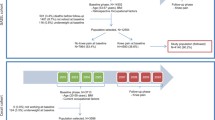Abstract
Objectives
The use of snap-fits in car-part assembling has developed into an industrial standard. Cross-sectional evidence indicates, however, that this assembling process might adversely affect workers’ upper limb function. The objective of this study was to analyze incident cases of upper limb functional limitations (ULFL) in relation to exposure to snap-fit assembly.
Methods
We performed a nested case–control study within a population of 5139 blue-collar automotive production workers. Cases with ULFL detected during follow-up were matched with controls based on employment duration and investigated on their exposure to snap-fit assembly. By conditional logistic regression, we modeled the risk for ULFL according to person-years of exposure to snap-fit assembly, adjusted for gender and baseline BMI.
Results
Overall, 64 ULFL cases were detected during a follow-up of 20610.8 person-years (3.1 cases per 1000 person-years). Cases, matched with an average of 4 controls, had significantly longer exposure duration to snap-fit assembly compared with controls (M = 1.15 person-years, SD = 1.68 person-years vs. M = 0.41 person-years, SD = 1.25 person-years). One person-year of exposure to snap-fit assembly was associated with an approximate 20% risk increase of developing ULFLs (OR 1.23, 95% CI 1.08–1.39).
Conclusions
We confirm an association between accumulated exposure to snap-fits in car-part assembling and upper limb musculoskeletal disorders. Company physicians should thus be vigilant to symptoms of musculoskeletal disorders of the upper limbs in snap-fit assembly and support the development of threshold values for snap-fit insertion forces.

Similar content being viewed by others
References
de Stampa M, Latouche A, Derriennic F, Monfort C, Touranchet A, Cassou B (2012) The course of physical functional limitations and occupational conditions in a middle-aged working population in France. J Occup Med Toxicol 7:5
Franklin GM, Haug J, Heyer N, Checkoway H, Peck N (1991) Occupational carpal tunnel syndrome in Washington State, 1984–1988. Am J Public Health 81:741–746
Franzblau A, Werner R, Valle J, Johnston E (1993) Workplace surveillance for carpal tunnel syndrome: a comparison of methods. J Occup Rehabil 3:1–14
Gardner BT, Dale AM, VanDillen, Franzblau A, Evanoff BA (2008) Predictors of upper extremity symptoms and functional impairment among workers employed for 6 months in a new job. Am J Ind Med 51:932–940
Genc SR, Messler WJ, Gabriel G (1998) A systematic approach to integral snap-fit attachment design. Res Eng Des 10:84–93
Kim KS, Kim MG (2010) Gender-related factors associated with upper extremity function in workers. Saf Health Work 1:158–166
Landau K (2009) Productivity improvement with snap-fit systems. In: Schlick M industrial engineering and ergonomics—visions, concepts, methods and tools festschrift in honor of Professor Holger Luczak. Springer, Berlin, pp 595–608
Mondelli M, Giannini F, Giacchi M (2002) Carpal tunnel syndrome incidence in a general population. Neurology 58:289–294
Mustard CA, Chambers A, Ibrahim S, Ethces J, Smith P (2015) Time trends in musculoskeletal disorders attributed to work exposures in Ontario using three independent data sources, 2004–2011. Occup Envoron Med 72:252–257
Ohlander J, Keskin MC, Stork J, Radon K (2015) Shift work and hypertension: prevalence and analysis of disease pathways in a German car manufacturing company. Am J Ind Med 58:549–560
Ohlander J, Keskin MC, Weiler S, Stork J, Radon K (2016) Snap-fits and upper limb functional limitations in German automotive workers. Occup Med (Lond) 66:471–477
Palmer KT, Harris EC, Coggon D (2007) Carpal tunnel syndrome and its relation to occupation: a systematic literature review. Occup Med (Lond) 57:57–66
Salmanzadeh H, Meyer M, Bopp V, Landau K, Bruder R (2010) Untersuchung des Einflusses von Scharfkantigkeit und Fügekraft auf Fügezeit und muskuläre Beanspruchung während der Clipsarbeit. Zeitschrift für Arbeitswissenschaft 64:111–121
Scharnbacher J, Claus M, Reichert J, Rohrl T, Hoffmann U, Ulm K, Letzel S, Nowak D (2013) Hypothenar hammer syndrome: a multicenter case-control study. Am J Ind Med 56:1352–1358
Schaub K, Caragnano B, Britzke B, Bruder R (2013) The European assembly worksheet. Theor Issues Ergon Sci 14:616–639
Simonsick EM, Kasper JD, Guralnik JM, Bandeen-Roche K, Ferrucci L, Hirsch R, Leveille S, Rantanen T, Fried LP (2001) Severity of upper and lower extremity functional limitation: scale development and validation with self-report and performance-based measures of physical function. WHAS Research Group. Women’s Health and Aging Study. J Gerontol B Psychol Sci Soc Sci 56:S10–S19
Spahn G, Wollny J, Hartmann B, Schiele R, Hofmann GO (2012) Metaanalysis for the evaluation of risk factors for carpal tunnel syndrome (CTS) Part II. Occupational risk factors. Z Orthop Unfall 150:516–524
Spallek M, Kuhn W, Uibel S, van Mark A, Quarcoo D (2010) Work-related musculoskeletal disorders in the automotive industry due to repetitive work—implications for rehabilitation. J Occup Med Toxicol 5:6
Werner RA, Franzblau A, Gell N, Hartigan AG, Ebersole M, Armstrong TJ (2005) Incidence of carpal tunnel syndrome among automobile assembly workers and assessment of risk factors. J Occup Environ Med 47:1044–1050
Zidkova V, Nakladalova M, Zapletalova J, Nakladal Z, Kollarova H (2017) Experiences with preventing carpal tunnel syndrome in an automotive plant. Int J Occup Med Environ Health 30:45–54
Acknowledgements
The authors would like to thank all study participants and the staff involved in the planning and execution of the company health check-ups. We would also like to thank Dr. Marschall for helping out with the data collection.
Funding
The work was supported by AUDI AG Germany.
Author information
Authors and Affiliations
Corresponding author
Ethics declarations
Conflict of interest
The authors declare that they have no conflict of interest.
Additional information
Publisher’s Note
Springer Nature remains neutral with regard to jurisdictional claims in published maps and institutional affiliations.
Rights and permissions
About this article
Cite this article
Ohlander, J., Keskin, MC., Weiler, S.W. et al. Snap-fit assembly and upper limb functional limitations in automotive production workers: a nested case–control study. Int Arch Occup Environ Health 92, 813–819 (2019). https://doi.org/10.1007/s00420-019-01418-3
Received:
Accepted:
Published:
Issue Date:
DOI: https://doi.org/10.1007/s00420-019-01418-3




